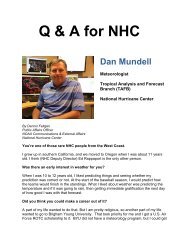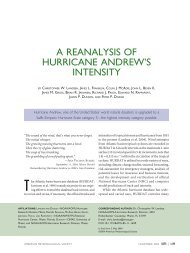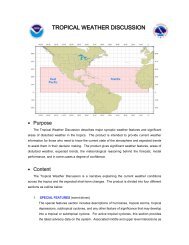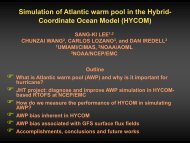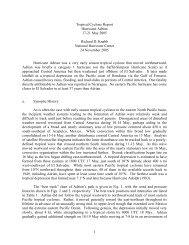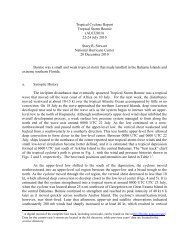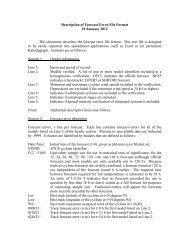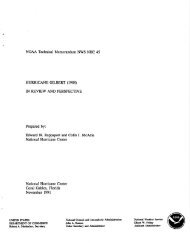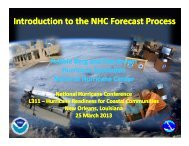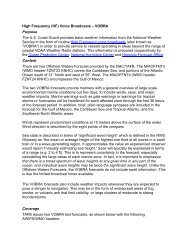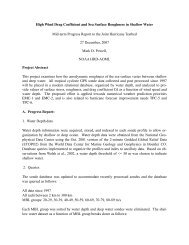the deadliest, costliest, and most intense united states hurricanes ...
the deadliest, costliest, and most intense united states hurricanes ...
the deadliest, costliest, and most intense united states hurricanes ...
You also want an ePaper? Increase the reach of your titles
YUMPU automatically turns print PDFs into web optimized ePapers that Google loves.
NOAA Technical Memor<strong>and</strong>um NWS TPC-3<br />
THE DEADLIEST, COSTLIEST, AND MOST INTENSE<br />
UNITED STATES HURRICANES FROM 1900 TO 2000<br />
(AND OTHER FREQUENTLY REQUESTED HURRICANE FACTS)<br />
Updated October 2001<br />
Jerry D. Jarrell, TPC Miami (retired)<br />
Max Mayfield, TPC Miami<br />
Edward N. Rappaport, TPC Miami<br />
Christopher L<strong>and</strong>sea, HRD Miami<br />
Tropical Prediction Center<br />
National Hurricane Center<br />
Miami, Florida<br />
October 2001<br />
UNITED STATES<br />
DEPARTMENT OF COMMERCE<br />
Donald L. Evans, Secretary<br />
National Oceanic <strong>and</strong> Atmospheric Administration<br />
Conrad C. Lautenbacher, Jr<br />
Under Secretary <strong>and</strong> Administrator<br />
National Wea<strong>the</strong>r Service<br />
John J. Kelly, Jr.<br />
Assistant Administrator<br />
for Wea<strong>the</strong>r Services
PREFACE<br />
This version of <strong>the</strong> Deadliest, Costliest, <strong>and</strong> Most Intense United States Hurricanes from 1900 to<br />
2000 extends <strong>the</strong> work of Hebert et al. (1997) through <strong>the</strong> 2000 season. Its also includes an estimate<br />
of <strong>the</strong> monetary loss that historical <strong>hurricanes</strong> could exact on <strong>the</strong> cun-entproperty-at-risk in <strong>the</strong> same<br />
location. Chris L<strong>and</strong>sea, of <strong>the</strong> NOAA Hurricane Research Division of <strong>the</strong> Atlantic Oceanographic<br />
<strong>and</strong> Meteorological Laboratory, has joined as a co-author to add this section. Ed Rappaport has also<br />
joined this effort, while Paul Hebert, in his retirement from NOAA, no longer contributes to this<br />
report. Infonnation for Hawaii, Puerto Rico <strong>and</strong> <strong>the</strong> Virgin Isl<strong>and</strong>s, given in Table 14. was provided<br />
by Hans Rosendal <strong>and</strong> Raphael Mojica of <strong>the</strong> Wea<strong>the</strong>r Service Forecast Offices in Honolulu <strong>and</strong> San<br />
Juan, respectively.<br />
This update was begun under <strong>the</strong> leadership of Jerry Jarrell until his retirement in early 2000. He<br />
continued to participate in retirement.<br />
During 1995, <strong>the</strong> National Meteorological Center, which included <strong>the</strong> National Hurricane Center,<br />
was re-organized into <strong>the</strong> National Centers for Environmental Prediction (NCEP). Under NCEP,<br />
<strong>the</strong> National Hurricane Center became <strong>the</strong> Tropical Prediction Center (TPC), a name which more<br />
accurately reflects <strong>the</strong> broad scope of its responsibilities, <strong>and</strong> more formally publicizes that <strong>the</strong><br />
majority of its operational products were for tropical wea<strong>the</strong>r events exclusive of <strong>hurricanes</strong>. The<br />
name "National Hurricane Center" was retained to apply to <strong>the</strong> hurricane operations desk at TPC.<br />
We will follow <strong>the</strong> convention where "NHC" refers to <strong>the</strong> previous National Hurricane Center,<br />
"TPC" refers to <strong>the</strong> current center <strong>and</strong> "TPC/NHC" refers to <strong>the</strong> hurricane operations desk ofTPC.
THE DEADLIEST, COSTLIEST, AND MOST INTENSE<br />
UNITED STATES HURRICANES FROM 1900 TO 2000<br />
(AND OTHER FREQUENTLY REQUESTED HURRICANE FACTS)<br />
.by<br />
Jerry D. Jarrell(retired), Max Mayfield, <strong>and</strong> Edward N. Rappaport<br />
NOAA/NWSI Tropical Prediction Center<br />
Miami, Florida<br />
Christopher W. L<strong>and</strong>sea<br />
NOAA! AOML/Hurricane Research Division<br />
Miami, Florida<br />
ABSTRACT<br />
This technical memor<strong>and</strong>um lists <strong>the</strong> thirty <strong>deadliest</strong> <strong>and</strong> <strong>costliest</strong> <strong>hurricanes</strong> in <strong>the</strong> United States<br />
from 1900-2000. The compilation ranks damage, as expressed by monetary losses, in three<br />
ways: 1) contemporary estimates; 2) contemporary estimates adjusted by inflation to 2000<br />
dollars; <strong>and</strong> 3) contemporary estimates adjusted for inflation <strong>and</strong> <strong>the</strong> growth of population <strong>and</strong><br />
personal wealth [pielke <strong>and</strong> L<strong>and</strong>sea, 1998]. In addition, <strong>the</strong> <strong>most</strong> <strong>intense</strong> (i.e., major)<br />
<strong>hurricanes</strong> to make l<strong>and</strong>fall in <strong>the</strong> United States during <strong>the</strong> period 1900-2000 are listed. Some<br />
additional statistics on United States <strong>hurricanes</strong> of this <strong>and</strong> previous centuries, <strong>and</strong> tropical<br />
cyclones in general, are also presented.<br />
1. INTRODUCnON<br />
The staff of <strong>the</strong> Tropical Prediction Center receives numerous requests for statistical infontlation<br />
on deaths <strong>and</strong> damages, incurred during <strong>hurricanes</strong> affecting <strong>the</strong> United States. Infontlation<br />
about <strong>the</strong> intensity of <strong>the</strong>se <strong>hurricanes</strong> is also frequently of interest. Estimates of <strong>the</strong>se measures<br />
vary in <strong>the</strong> literature. Our hope is to present <strong>the</strong> best compilation of currently available estimates.<br />
In some instances, data in our lists represent revised estimates based on more complete<br />
infontlation received following earlier publications including previous versions of this technical<br />
memor<strong>and</strong>um.<br />
There are o<strong>the</strong>r frequently asked questions about <strong>hurricanes</strong>, such as: What is <strong>the</strong> average<br />
number of <strong>hurricanes</strong> per year? What year(s) had <strong>the</strong> <strong>most</strong> <strong>and</strong> least <strong>hurricanes</strong>? What hurricane<br />
had <strong>the</strong> longest life? On what date did <strong>the</strong> earliest <strong>and</strong> latest hurricane occur? What was <strong>the</strong><br />
<strong>most</strong> <strong>intense</strong> Atlantic hurricane? What was <strong>the</strong> largest number of <strong>hurricanes</strong> in existence on <strong>the</strong><br />
same day? When was <strong>the</strong> last time a major hurricane or any hurricane hit a given community<br />
directly2? Answers to <strong>the</strong>se <strong>and</strong> several o<strong>the</strong>r questions are provided in Section 3.<br />
I A major hurricane is a category 3,4, or 5 hurricane on <strong>the</strong> Safflf/Simpson Hurricane Scale (see<br />
Table 1), <strong>and</strong> is comparable to a Great Hurricane in some o<strong>the</strong>r publications.<br />
2 A direct hit means experiencing <strong>the</strong> core of strong winds <strong>and</strong> high tides of a hurricane.<br />
1
Table 1. SaffirlSimpson Hurricane Scale [Simpson, R.H. (1974)].<br />
Central<br />
Scale Number Pressure Winds Surge<br />
1 >979 >28.91 74-95 4 to 5 Minimal<br />
2 965-979 28.50-28.91 96-110 6 to 8 Moderate<br />
3 945-964 27.91-28.47<br />
111-130 9 to 12 Extensive<br />
4 920-944<br />
27.17-27.88 131-155 13to18 Extreme<br />
5 < 920 < 27.17 > 155 >18 Catastrophic<br />
2
2. BACKGROUND AND DEFINIllONS<br />
Many of <strong>the</strong> statistics in this publication depend directly on <strong>the</strong> criteria used in preparing ano<strong>the</strong>r<br />
study, "Hurricane Experience Levels of Coastal County Populations-Texas to Maine" [(Jarrell et<br />
al. (1992)]. The primary purpose of that study was to demonstrate, count)' by count)'. <strong>the</strong> lov.-<br />
hurricane experience level of a large majority of <strong>the</strong> population. Statistics show that <strong>the</strong> largest<br />
loss of life <strong>and</strong>, for <strong>the</strong> <strong>most</strong> part, property occur in locations experiencing <strong>the</strong> core of a categoI")"<br />
3 or stronger hurricane.<br />
The SafrIT/Simpson category is defmed by pressure, wind, <strong>and</strong> stOmI surge. In nature, however.<br />
<strong>the</strong>re is not a one-to-one relationship between <strong>the</strong>se elements. Therefore, in practice, <strong>the</strong> TPC<br />
uses <strong>the</strong> maximum wind speed to establish <strong>the</strong> category. Operationally, however, <strong>the</strong> central<br />
pressure is often used to make a first estimate of <strong>the</strong> wind. Thereafter, available surface wind<br />
reports, aircraft reconnaissance flight-level. winds (from which surface wind speed can be<br />
estimated), <strong>and</strong> dropwindsonde data are used to anchor <strong>the</strong> wind estimate. In post-stOmI<br />
analysis, <strong>the</strong> central pressure ranges of <strong>hurricanes</strong> on <strong>the</strong> SafrIT/Simpson Hurricane Scale will<br />
usually agree fairly well with <strong>the</strong> wind ranges in that category. On <strong>the</strong> o<strong>the</strong>r h<strong>and</strong>, <strong>the</strong> stOmI<br />
surge is strongly dependent on <strong>the</strong> slope of <strong>the</strong> continental shelf (shoaling factor). This can<br />
change <strong>the</strong> height of <strong>the</strong> surge by a factor of two for a given central pressure <strong>and</strong>/or maximum<br />
wind.<br />
Heavy rainfall associated with a hurricane is nQ.t one of <strong>the</strong> criteria for categorizing.<br />
The process of assigning a category number to a hurricane is subjective, as is TPC's estimate of<br />
a cyclone's impact. It is made on a county by county basis. In this study, we applied <strong>the</strong> criteria<br />
for direct hit <strong>and</strong> indirect hit described in <strong>the</strong> work by Jarrell et at. (1992):<br />
Direct Hit -Using "R" as <strong>the</strong> radius of maximum winds in a hurricane (<strong>the</strong> distance in<br />
miles from <strong>the</strong> storm's center to <strong>the</strong> circle of maximum winds around <strong>the</strong> center), all or<br />
parts of counties falling within approximately 2R to <strong>the</strong> right <strong>and</strong> R to <strong>the</strong> left of a storm's<br />
l<strong>and</strong>fall point were usually considered to have received a direct hit (this assumes an<br />
observer at sea looking toward <strong>the</strong> shore.) If <strong>the</strong>re was no l<strong>and</strong>fall, <strong>the</strong> closest point of<br />
approach was used in place of <strong>the</strong> l<strong>and</strong>fall point). On average, this direct hit zone<br />
extended about 50 miles along <strong>the</strong> coastline (R = 15 miles). Of course, some <strong>hurricanes</strong><br />
were smaller than this <strong>and</strong> some, particularly at higher latitudes, were much larger. Cases<br />
were judged individually, <strong>and</strong> many borderline situations had to be resolved.<br />
3
Indirect Hit -In general, areas on ei<strong>the</strong>r side of <strong>the</strong> direct hit zone which received wind<br />
gusts of hurricane force <strong>and</strong>/or tides of at least 4 to 5 feet above non11al were considered<br />
to have had an indirect hit. The evaluation subjectively incorporated a hurricane's strength<br />
<strong>and</strong> size, <strong>and</strong> <strong>the</strong> configuration of county coastlines.<br />
The authors acknowledge that <strong>the</strong>re are limitations to this technique. For example. <strong>the</strong> effect of<br />
an indirect hit by a large category 4 hurricane can be greater than that by a direct hit from a small<br />
category I hurricane.<br />
Neumann et al. (1999) gives <strong>the</strong> variation in tropical cyclone frequency along <strong>the</strong> United States<br />
coastline for all tropical storms <strong>and</strong> <strong>hurricanes</strong>, <strong>hurricanes</strong> only, <strong>and</strong> major <strong>hurricanes</strong> (category 3<br />
or greater). In that study, counts were made of <strong>the</strong> number of tropical cyclones or <strong>hurricanes</strong><br />
whose center passed within 75 nautical miles of <strong>the</strong> coastal location. This counting method thus<br />
includes near-misses, as well as direct <strong>and</strong> indirect hits as defined above.<br />
Statistics on tropical stOnIl <strong>and</strong> hurricane activity in <strong>the</strong> North Atlantic Ocean (which includes<br />
<strong>the</strong> Gulf of Mexico <strong>and</strong> <strong>the</strong> Caribbean Sea) can be found in Neumann et al. (1999). A<br />
stratification of <strong>hurricanes</strong> by category which have affected coastal counties of <strong>the</strong> Gulf of<br />
Mexico <strong>and</strong> North Atlantic Ocean can be found in Jarrell et al. (1992). Additional infonIlation<br />
about <strong>the</strong> impact of <strong>hurricanes</strong> can be found in annual hurricane season articles in Monthly<br />
Wea<strong>the</strong>r Review <strong>and</strong> StOnIl Data .<br />
4
3. DISCUSSION<br />
Part I<br />
The remainder of this memor<strong>and</strong>um provides answers to some of <strong>the</strong> <strong>most</strong> frequently asked<br />
questions about <strong>the</strong> characteristics <strong>and</strong> impacts of <strong>the</strong> tropical cyclones to affect <strong>the</strong> United States<br />
from 1900-2000.<br />
(1) What have been <strong>the</strong> <strong>deadliest</strong> <strong>hurricanes</strong> in <strong>the</strong> United States? Table 2 lists <strong>the</strong> 30<br />
<strong>deadliest</strong> tropical cyclones to strike <strong>the</strong> U.S. mainl<strong>and</strong> 1900-2000. Three <strong>hurricanes</strong> prior to<br />
1900, a tropical storm which affected sou<strong>the</strong>rn California in 1939 <strong>and</strong> <strong>the</strong> <strong>deadliest</strong> Puerto Rico<br />
<strong>and</strong> Virgin Isl<strong>and</strong>s <strong>hurricanes</strong> are listed as an addendum.<br />
(2)- What have been <strong>the</strong> <strong>costliest</strong> <strong>hurricanes</strong> in <strong>the</strong> United States? Table 3 lists <strong>the</strong> 30<br />
<strong>costliest</strong> tropical cyclones (includes 5 tropical storms) to strike <strong>the</strong> U.S. mainl<strong>and</strong> 1900-2000.<br />
Figures are not adjusted for inflation. Table 3a re-orders some of <strong>the</strong>se plus several o<strong>the</strong>r<br />
<strong>hurricanes</strong> after adjusting to 2000 dollars3. Hawaiian, eastern Pacific, Puerto Rican <strong>and</strong> Virgin<br />
Isl<strong>and</strong> tropical cyclones are listed as addenda to Tables 3 <strong>and</strong> 3a. Table 3a also lists <strong>the</strong> thirty<br />
<strong>costliest</strong> <strong>hurricanes</strong> 1900-2000 assuming that a hurricane having <strong>the</strong> same track, size <strong>and</strong><br />
intensity as noted in <strong>the</strong> historical record would strike <strong>the</strong> area with today' s population <strong>and</strong><br />
property-at-risk (see Pielke <strong>and</strong> L<strong>and</strong>sea 1998.)<br />
(3) What have been <strong>the</strong> <strong>most</strong> <strong>intense</strong> <strong>hurricanes</strong> to strike <strong>the</strong> United States? Table 4 lists<br />
<strong>the</strong> 65 major <strong>hurricanes</strong> which have struck <strong>the</strong> U.S. mainl<strong>and</strong> 1900-2000. Hurricanes are ranked<br />
by estimated central pressure at time of l<strong>and</strong>fall. Hawaiian, Puerto Rican <strong>and</strong> Virgin Isl<strong>and</strong><br />
<strong>hurricanes</strong> are listed as an addenda to Table 4. Many of <strong>the</strong> isl<strong>and</strong> <strong>hurricanes</strong> are close passes, as<br />
opposed to l<strong>and</strong>falls as defined above.<br />
A look at <strong>the</strong> lists of <strong>deadliest</strong> <strong>and</strong> <strong>costliest</strong> <strong>hurricanes</strong> 1900-2000 reveals several striking facts:<br />
(1) Ten of <strong>the</strong> twelve <strong>deadliest</strong> <strong>hurricanes</strong> were <strong>the</strong> equivalent of a category 4 or higher. (2)<br />
Large death totals were primarily a result of <strong>the</strong> 15 to 20 feet or greater rise of <strong>the</strong> ocean (storm<br />
surge) associated with many of <strong>the</strong>se major <strong>hurricanes</strong>. All but six of <strong>the</strong> ~rty <strong>deadliest</strong><br />
<strong>hurricanes</strong> were major <strong>hurricanes</strong>. Four of those six were <strong>the</strong> inl<strong>and</strong> flood-producing <strong>hurricanes</strong><br />
Agnes, Diane <strong>and</strong> Floyd <strong>and</strong> tropical storm Alberto. (3) A large portion of <strong>the</strong> damage in two of<br />
<strong>the</strong> eight <strong>costliest</strong> tropical cyclones (Table 3) resulted from inl<strong>and</strong> flooding caused by torrential<br />
rain. (4) Half of <strong>the</strong> <strong>deadliest</strong> <strong>hurricanes</strong> were category four or higher, but only one-sixth of <strong>the</strong><br />
<strong>costliest</strong> <strong>hurricanes</strong> (Table 3) met this criterion. (5) Only one of <strong>the</strong> <strong>deadliest</strong> <strong>hurricanes</strong> occurred<br />
during <strong>the</strong> past twenty five years in contrast to two-thirds of <strong>the</strong> <strong>costliest</strong> <strong>hurricanes</strong> (this drops to<br />
two-fifths after adjustment for inflation <strong>and</strong> to one quarter after adjustment for inflation,<br />
population, <strong>and</strong> personal wealth).<br />
Addenda to Tables 2, 3 <strong>and</strong> 4 include some noteworthy storms from before 1900, from <strong>the</strong> U.S.<br />
West coast <strong>and</strong> <strong>the</strong> Hawaiian isl<strong>and</strong>s, as well as in <strong>the</strong> U. S. Caribbean isl<strong>and</strong>s. The rank<br />
represents <strong>the</strong> position <strong>the</strong>y would occupy if included in <strong>the</strong> main table.<br />
J Adjusted to 2000 dollars on basis of U.S. Departtnent of Commerce Implicit Price Deflator for Construction Available index numbers are<br />
rounded to <strong>the</strong> nearest tenth This rounding can result in slight changes in <strong>the</strong> adjusted damage of one hurricane ~Iative to o<strong>the</strong>rs.<br />
~<br />
5
Table 2. The thirty <strong>deadliest</strong> mainl<strong>and</strong> United States tropical cyclones 1900-2000<br />
1<br />
2<br />
3<br />
4<br />
5<br />
6<br />
7<br />
8<br />
9<br />
10<br />
11<br />
12<br />
13<br />
14<br />
15<br />
16<br />
17<br />
18<br />
19<br />
20<br />
21<br />
22<br />
22<br />
24<br />
25<br />
26<br />
26<br />
28<br />
29<br />
30<br />
30<br />
TX (Galveston)<br />
FL (SE/Lake 0 keechobee)<br />
FL (Keys)/S TX<br />
New Engl<strong>and</strong><br />
FL (Keys)<br />
AUDREY (SW LA/N TX)<br />
NE U.S.<br />
LA (Gr<strong>and</strong> Isle)<br />
LA (New Orleans)<br />
TX (Galveston)<br />
CAMILLE (MS/SE LANA)<br />
FL (M iam I)/M SIAL/Pensacola<br />
DIANE (NE U.S.)<br />
SE FL<br />
M SIAL/Pensacola<br />
AGNES (FL/NE U.S.)<br />
HAZEL (SC/NC)<br />
BETSY (SE FL/SE LA)<br />
CAROL (NE U.S.)<br />
FLOYD (Mid Atlantic & NE U.S.)<br />
SE FL/SE LA/MS<br />
DONNA (FL/Eastern U.S.)<br />
GA/SC/NC<br />
CARLA (N & Central TX)<br />
TX (Velasco)<br />
TX (Freeport)<br />
STX<br />
HILDA (Central LA)<br />
SW LA<br />
SW FL<br />
ALBERTO (NW FL,GA,AL)<br />
ADDENDUM (Pre.1900 or Not Atlantic/Gulf Coast)<br />
2 LA 1893 Unk 2000<br />
2-3 SC/GA 1893 Unk 1000-2000<br />
3 GA/SC 1881 2 700<br />
9 Puerto Rico 1928 4 312<br />
13 U SVI. Puerto Rico 1932 2 225<br />
17 DONNA (St. Thomas. VI) 1960 4 107<br />
25 Sou<strong>the</strong>rn California 1939 TS .45<br />
25 ELOISE(Puerto Rico) 1975 TS' 44<br />
.Could be as high as 10,000 to 12.000<br />
.Moving more than 30 miles per hour<br />
.Over 500 lost on ships at sea; 600-900 estimated deaths<br />
C Some 344 of <strong>the</strong>se lost on ships at sea.<br />
& Only of Tropical Storm intensity.<br />
Unk Intensity not sufficiently known to establish category<br />
6
Table 3. The thir1y <strong>costliest</strong> mainl<strong>and</strong> United States tropical cyclones. 1900-2000.<br />
RANK HURRICANE YEAR CATEGORY DAMAGE (U.S.)<br />
, -,<br />
1 ANDREW (SE FUSE LA) 1992 4 $26,500,000,000<br />
2 HUGO (SC) 1989 4 7,000.000.000<br />
3 FLOYD (Mid Atlantic & NE U.S.) 1999 2 4,500,000,000<br />
4 FRAN (NC) 1996 3 3,200,000,000<br />
5 OPAL (NW FUAL) 1995 3 3,000,000,000<br />
6 GEORGES (FL Keys, MS,AL) 1998 2 2,310,000,000<br />
7 FREDERIC (AL, MS) 1979 3 2,300,000,000<br />
8 AGNES (FL./NE U.S.) 1972 1 2,100,000,000<br />
9 ALICIA (N TX) 1983 3 2,000,000.000<br />
10 BOB (NC, NE U.S) 1991 2 1,500,000.000<br />
10 JUAN (LA) 1985 1 1,500.000.000<br />
12 CAMILLE (MS/SE lA/VA) 1969 5 1,420,700,000<br />
13 BETSY (SE FUSE LA) 1965 3 1,420,500,000<br />
14 ELENA (MS/AUNW FL) 1985 3 1,250,000,000<br />
15 GLORIA (Eastem U.S.) 1985 3. 900,000,000<br />
16 DIANE (NEU.S.) 1955 1 831,700,000<br />
17 BONNIE (NC,VA) 1998 2 720,000,000<br />
18 ERIN (NW FL) 1995 2 700.000,000<br />
19 ALLISON (N TX) 1989 TS c 500,000.000<br />
19 ALBERTO (NW FL,GA,AL) 1994 TS c 500,000,000<br />
19 FRANCES (TX) 1998 TS c 500,000,000<br />
22 ELOISE (NW FL) 1975 3 490,000,000<br />
23 CAROL (NE U.S.) 1954 3. 461,000,000<br />
24 CELIA (S TX) 1970 3 453,000,000<br />
25 CARLA (N & Central TX) 1961 4 408,000,000<br />
26 CLAUDETTE (N TX) 1979 TS c 400,000.000<br />
26 GORDON (S & Cent FL,NC) 1994 TS C 400,000,000<br />
28 DONNA (FUEastem U.S.) 1960 4 387,000,000<br />
29 DAVID (FUEastem U.S.) 1979 2 320,000.000<br />
30 1938 3 .306,000.000<br />
ADDENDUM (Rank is independent of o<strong>the</strong>r events in group)<br />
4 GEORGES (USVI,PR) 1998 3 3,600,000,000<br />
10 INIKI (Kauai. HI) 1992 Unk. 1,800,000.000<br />
10 MARILYN (USVI, PR) 1995 2 1,500,000,000<br />
15 HUGO (USVI, PR) 1989 4 1,000,000,000<br />
19 HORTENSE (PR) 1996 1 500,000.000<br />
29 LENNY (USVI. PR) 1999 4 330.000,000<br />
29 OLIVIA (CA) 1982 T.D. & 325.000.000<br />
30 IWA (Kauai, HI) 1982 Unk. 312,000,000<br />
Notes:<br />
.Moving more than 30 miles per hour<br />
C Only of Tropical Storm intensity<br />
& Only a Tropical Depression<br />
7
0<br />
0<br />
0<br />
':'<br />
0<br />
0<br />
c- ..<br />
II<br />
C<br />
0<br />
U<br />
>-<br />
u<br />
..<br />
~<br />
Co<br />
g ..<br />
!?<br />
~<br />
II)<br />
~<br />
!?<br />
C<br />
::><br />
~<br />
c~<br />
So<br />
.. Ẹ.<br />
~ ..0u<br />
"f;<br />
:5<br />
II<br />
.c<br />
...<br />
..<br />
'"<br />
.! .c<br />
..<br />
.<br />
ċ<br />
0<br />
= .<br />
..!!.<br />
~<br />
0<br />
Z<br />
.c.<br />
~<br />
.<br />
'D<br />
Cċ<br />
:!<br />
..! .<br />
~<br />
0.<br />
0<br />
A.<br />
C<br />
0<br />
=w<br />
..!z<br />
-<<br />
':u<br />
0"<br />
:~<br />
N:><br />
D~<br />
.: .~<br />
'Ḍ<br />
~<br />
C.~<br />
-<br />
000000000000000000000000000000<br />
0 0 0 0 0 0 0 0 0 0 0 0 0 0 0 0 0 0 0 0 0 0 0 0 0 0 0 0 0 0<br />
o. o. o. ~ o. o. o. o. o. o. o. o. o. o. o. o. o. o. o. o. o. o. o. o. o. o. o. o. o. o.<br />
0 0 0 000 0 0 0 0 0 0 0 0 0 0 0 0 0 0 0 0 0 0 0 0 0 0 0 0<br />
0 0 0 0 0 0 0 0 0 0 0 0 0 0 0 0 0 0 0 0 0 0 0 0 0 0 0 0 0 0<br />
~ O. O. O. O. O. O. O. O. O. ~ O. O. ~ O. ~ ~ O. O. O. O. O. O. O. O. O. O. O. O. O.<br />
...~O O-~ -0 ~C"II)"'CII)N~ o eeo 0 ,,"'II)"'~ N<br />
~ C C C C') ..C') 01 N -0 C') 0 N -N e 01 -e C') ..01 eN.. C') -C') 01<br />
-CO-C')O~CII)NC~~CO~"",~II)O"C~O"""~OIC<br />
~~N~CC~..MNN~CC~~~~~~~...MMMNN<br />
e~~NNN<br />
...<br />
CO) CO) ..CO) .."' CO) CO) CO) CO) CO) ..CO) N CO) N CO) CO) N -<br />
..~<br />
..~~~~~N~~~~~.N~.~~N...N~~~~..<br />
!<br />
~ċ<br />
~N"'a."'~a.CCD""""-C"'OO"'-"CD"""""""""'O<br />
C"'CDCD"'...a a.a.C"'CDa.CCD"'Ca."'N-C"'C"~"O<br />
~a.~~a.a.a.a.a.~a.a.~a.a.a.a.a.a.a.a.a.a.~a.a.a.a.~<br />
0 ~ I/)<br />
0<br />
0<br />
N<br />
m<br />
:::i ':; ...<br />
..:<br />
~<br />
--w -~~ :::i'" ~ ~<br />
-- -_ 0<br />
-"W -~ ~ ~ ><br />
:><br />
...:> W_~C ...~C~ -zU) U- -C -<br />
...~I/) "-..! < U)~ ., _-IVC ...~ -U) C<br />
'U~a:<br />
W U)"'- IV "':>U"O ~ X~O<br />
W Z...I/)~« "' X-~U... W-ee~a~- W --~ -.~~~e- -_ZZ~~<br />
.o~ ~cEII- ~c<br />
~~..-W~(/)Z=WWOO~~W~Q~.~>~~~~O~<br />
~WmmoC~>~<br />
(1)---(1)<br />
I£I;~~~<br />
~~>---=<br />
Q::-=O~<br />
O~Q:~c<br />
~I£I~
=-<br />
16<br />
'6 c~<br />
G><br />
II) c<br />
G><br />
:s<br />
'Ui<br />
0<br />
E<br />
~<br />
.~<br />
:5<br />
;a<br />
81<br />
G><br />
c<br />
~<br />
u<br />
"E ~<br />
.c<br />
%<br />
E>c<br />
0<br />
II)<br />
GO<br />
'C<br />
~<br />
U<br />
..§.<br />
0<br />
0<br />
0<br />
N<br />
,;,<br />
0<br />
~<br />
,,;<br />
GO<br />
C<br />
'8<br />
"E ~<br />
.c<br />
II)<br />
G><br />
;a<br />
<br />
'C c<br />
~<br />
C16E<br />
G><br />
II)<br />
C<br />
G><br />
:s<br />
'Ui<br />
~<br />
G><br />
.c<br />
l-<br />
Ġ><br />
:c ~<br />
I-<br />
w<br />
a:<br />
~;~~~~~~--~~~OOOOO~~~~~~~N~~~ ~~<br />
OO~~~~~~~~~~~~NN~~~~NNNNN~MMM~~~~~~~<br />
OOU~~~~~~~~~~~~~~~~~~~~~~~~~~~~~~~~~<br />
W£NNNNNNNNNNNNNNNNNNNNNNNNNNNNNNNNN<br />
a:<br />
a.<br />
~ ~<br />
~ .om 0000 --N N ~ ~ ~ ~ ~ ~ ~ ~ ~ ~ ~ ~ ~ ~ ~ ~ 0 0 0 N N N N M ~<br />
Z -<br />
-~<br />
~._~~~~~~~~~~~~~~~~~~~~~~~~~~~~~~~~~<br />
-=~~~~~~~~~~~~~~~~~~~~~~~~~~~~~~~~~<br />
~ >-<br />
a:=<br />
O~<br />
'"' "C. c . .<br />
WmMMMMMMMMMMMMMM~MMMMMMMMMMMMMMMMMM<br />
"'~N--C')O~.-OO~Il)Il)C>~Il).C').~<br />
WC>C>C>C>C>C>C>C>C>C>C>C>C>C>C>C>C>C>C>C>C>C>C>C>C>C>C>C>C>C>C>C>C><br />
><br />
-5'E<br />
i<br />
< iij~ 5:- -<br />
_oJ _.="5>,:j' Zuj <<br />
Xiij >occ '"- _::J. ,:j' ~ ~~ xu~ ~<br />
z~c~~ xm~~ ->'"- ~w -~z'"- '"-<br />
~~£~~ ;~~~ ~~~5 ~~ ~~~~~~~5w<br />
~~~~~~~~~~~~5;~5~ ~~x~x~~~~~~~2~2~<br />
~W~~XW~~ ~<br />
~8 ~-~~.~N~~~~OO~~.~~~~~~.~ ~~~N~ON~<br />
_~~~-N~ -~~N~.~~~~-~~~~.O~N~--~~ ~N~~~~~~<br />
W~~~~~~ ~~~~~~~~~~~~~~~~~~~~~~~~ ~~~~~~~~<br />
«--'":- '" x "8 ~ -a: - -<br />
~ ..J I- ~ X a:<br />
-~ '":- -~<br />
WC C "'I- .~<br />
'" ~ ~ ~E "'ffi Z Cii S -., 05<br />
.., OC .=.., -.,. W a: ~<br />
w~ ~~ 0~ ~ '" ~~, ~ '" -~-=E-><br />
~~X~~--~ U~ ~G~ ~~~- :J:J a: ā: 05~~~~'"<br />
"'WI-Q)W~Q)tO "'Z.,. ~~~~-- < ~ ~ ~<br />
~ ~~",~2~~~05G~U~ ~~~~~~-g; W~ G ~O~~
Table 4a summarizes <strong>the</strong> direct hits on<br />
<strong>the</strong> U.S. mainl<strong>and</strong> since 1900.<br />
Table 4a. Direct hits by n-ainl<strong>and</strong> United States<br />
Hurricanes (1900-1999).<br />
The data indicate that an average of 2<br />
major <strong>hurricanes</strong> every 3 years made<br />
l<strong>and</strong>fall somewhere along <strong>the</strong> U.S.<br />
Gulf or Atlantic coast. (When all<br />
categories were combined, about 5<br />
<strong>hurricanes</strong> made l<strong>and</strong>fall every 3<br />
years. )<br />
One- of <strong>the</strong> greatest concerns of <strong>the</strong><br />
National Wea<strong>the</strong>r Service's (NWS)<br />
hurricane preparedness officials is that<br />
in a hurricane because of our advanced technolo~. Max Mayfield, spokesman for <strong>the</strong> NWS<br />
hurricane warning service <strong>and</strong> Director of TPC, as well as fonDer NHC Directors, have<br />
repeatedly emphasized <strong>the</strong> great danger of a catastrophic loss of life in a future hurricane if<br />
proper preparedness plans for vulnerable areas are not fonnulated, maintained <strong>and</strong> executed.<br />
The study by Jarrell et al. (1992) used 1990 census data to estimate that 85% of U.S. coastal<br />
residents from Texas to Maine had ~ experienced a direct hit by a major hurricane. Many of<br />
those 45 million residents had moved to coastal sections during <strong>the</strong> past twenty-five years. Even<br />
<strong>the</strong> l<strong>and</strong>falls of Andrew, Hugo, Opal, Fran <strong>and</strong> Bret have not lessened an ever growing concern<br />
brought by <strong>the</strong> continued increase in coastal populations.<br />
Table 5, which lists <strong>hurricanes</strong> by decade since 1900, shows that during <strong>the</strong> twenty year period<br />
1960-1979 both <strong>the</strong> number <strong>and</strong> intensity of l<strong>and</strong> falling U.S. <strong>hurricanes</strong> decreased sharply!<br />
Based on 1900-1959 statistics, <strong>the</strong> expected number of <strong>hurricanes</strong> <strong>and</strong> major hUITicanes during<br />
<strong>the</strong> period 1960-1979 was 36 <strong>and</strong> 15, respectively. But, in fact, only 27 (or 75%) of <strong>the</strong> expected<br />
number of <strong>hurricanes</strong> struck <strong>the</strong> U.S. with only 10 major <strong>hurricanes</strong> or 67% of that expected<br />
number. The decade of <strong>the</strong> eighties showed little change to this trend. Even <strong>the</strong> decade of <strong>the</strong><br />
nineties, showed below average l<strong>and</strong>fall frequencies. It could be noted that of <strong>the</strong> <strong>most</strong> recent<br />
four decades, only <strong>the</strong> 70's <strong>and</strong> 90's were significantly below nonnal.<br />
On <strong>the</strong> average, a category 4 or stronger hurricane strikes <strong>the</strong> United States once every 6 years.<br />
Even though two category 4 <strong>hurricanes</strong> struck within three years, (Hugo in 1989 <strong>and</strong> Andrew in<br />
1992), <strong>the</strong>y represent <strong>the</strong> only category 4 <strong>hurricanes</strong> since 1969. Fewer <strong>hurricanes</strong> in a year do<br />
not necessarily mean a lesser threat of disaster, however. The 1919 hurricane, which is both <strong>the</strong><br />
third <strong>deadliest</strong> <strong>and</strong> fourth <strong>most</strong> <strong>intense</strong> to strike <strong>the</strong> United States beginning 1900, occurred in a<br />
year which had a total of only three storms/<strong>hurricanes</strong>. Records for <strong>the</strong> <strong>most</strong> <strong>intense</strong> U.S.<br />
hurricane in 1935, <strong>and</strong> <strong>the</strong> <strong>costliest</strong>, Andrew in 1992, occurred in years which had only six<br />
tropical storms or <strong>hurricanes</strong>.<br />
10
A large death toll in a<br />
U.S. hurricane is still<br />
possible. The decreased<br />
death totals in recent years<br />
may be as much a result of<br />
lack of major <strong>hurricanes</strong><br />
striking <strong>the</strong> <strong>most</strong><br />
vulnerable areas as <strong>the</strong>y<br />
are of any fail-proof<br />
forecasting, warning, <strong>and</strong><br />
observing systems.<br />
Continued coastal growth<br />
<strong>and</strong> inflation will al<strong>most</strong><br />
certainly result in every<br />
future major l<strong>and</strong>falling<br />
hurricane (<strong>and</strong> even<br />
weaker <strong>hurricanes</strong> <strong>and</strong><br />
tropical storms) replacing<br />
one of <strong>the</strong> current <strong>costliest</strong><br />
<strong>hurricanes</strong>.<br />
Table 5. Number of <strong>hurricanes</strong> by category to strike <strong>the</strong> mainl<strong>and</strong> U.S.<br />
each decade. (Updated from Hebert et al.. 1997)<br />
Category<br />
DECADE 1 2 3 4 5<br />
1900-1909 5<br />
1910-1919 9<br />
1920-1929 6<br />
1930-1939 4<br />
1940-1949 7<br />
1950-1959 8<br />
1960-1969 4<br />
1970-1979 6<br />
1980-1989 9<br />
1990-1999 3<br />
2000-2009 0<br />
4<br />
3<br />
4<br />
5<br />
8<br />
1<br />
5<br />
2<br />
1<br />
6<br />
0<br />
4<br />
5<br />
3<br />
6<br />
7<br />
7<br />
3<br />
4<br />
5<br />
4<br />
0<br />
2<br />
3<br />
2<br />
1<br />
1<br />
2<br />
2<br />
0<br />
1<br />
1<br />
0<br />
0<br />
0<br />
0<br />
1<br />
0<br />
0<br />
1<br />
0<br />
0<br />
0<br />
0<br />
ALL<br />
1.2.3.4.5 ~ 3.4.5<br />
15<br />
20<br />
15<br />
17<br />
23<br />
18<br />
15<br />
12<br />
16<br />
14<br />
0<br />
1900-1999 61 39 48 15 2 165 65<br />
Note: Only <strong>the</strong> highest category to affect <strong>the</strong> U.S. has beer) used<br />
6<br />
8<br />
5<br />
8<br />
8<br />
9<br />
6<br />
4<br />
6<br />
5<br />
0<br />
If warnings are heeded<br />
<strong>and</strong> preparedness plans developed, <strong>the</strong> death toll can be reduced. In <strong>the</strong> absence of a change of<br />
attitude or laws restricting building near <strong>the</strong> ocean, however, large property losses are inevitable.<br />
11
Part II<br />
This section answers some frequently asked questions about tropical stonn <strong>and</strong> hunicane<br />
activity .<br />
(1) What is <strong>the</strong> average<br />
number of <strong>hurricanes</strong> per<br />
year? Table 6 gives <strong>the</strong><br />
average number of tropical<br />
cyclones which reached storm<br />
strength <strong>and</strong> hunoicane strength<br />
during selected time periods.<br />
A total of ten tropical cyclones<br />
reaching storm strength with<br />
six of <strong>the</strong>se becoming<br />
hunoicanes appears to be <strong>the</strong><br />
best averages to use based on<br />
<strong>the</strong> past 10 to 50 year time<br />
periods when adequate<br />
observing systems were in<br />
place.<br />
T aJe 6. ~ ruTt8" ci trqJc3 c.)OOe Mdl ~ starn ~<br />
h..ITica-e ~ fcr vaia.6~. ~e:j frtm t..e.JTBm 8 cI. (1~).<br />
(2) What year(s) have had <strong>the</strong> <strong>most</strong> Table 7 Years maximum <strong>and</strong> minimum tropical cyck>ne <strong>and</strong> hurrM;ane activity<br />
.? in <strong>the</strong> Nonh Atlantic, Caribbean, <strong>and</strong> Gulf of Mexico 1871.2000 Updated from<br />
<strong>and</strong> least hurncanes.<br />
Neumann et al. (1999) Note, some activity undoubtely not observed in early<br />
Table 7 shows <strong>the</strong> years of maximum years.<br />
<strong>and</strong> minimum tropical cyclone <strong>and</strong><br />
hurricane activity for <strong>the</strong> Atlantic<br />
hurricane basin. The only years<br />
after 1900 when a hurricane failed to<br />
strike <strong>the</strong> U.S. mainl<strong>and</strong> were 1902,<br />
1905, 1907, 1914, 1922, 1927, 1930,<br />
1931, 1937, 1951, 1958, 1962, 1973,<br />
1978,1981,1982,1990,1994 <strong>and</strong><br />
2000. Note that only twice has <strong>the</strong> U.S.<br />
mainl<strong>and</strong> gone as long as two years<br />
without a hurricane. The <strong>most</strong><br />
<strong>hurricanes</strong> to strike in one year were<br />
six in 1916 <strong>and</strong> 1985. There were five<br />
in 1933, <strong>and</strong> four in 1906, 1909, <strong>and</strong><br />
1964. Three <strong>hurricanes</strong> struck <strong>the</strong> U.S.<br />
in one year a total of sixteen times. Ten<br />
of <strong>the</strong>se sixteen times occurred during<br />
<strong>the</strong> sixteen years from 1944 to 1959!<br />
13
(3) When did <strong>the</strong> earliest <strong>and</strong> latest <strong>hurricanes</strong> occur? The hurricane season is defined as<br />
June 1 through November 30. An early hurricane can be defmed as occurring in <strong>the</strong> three months<br />
prior to <strong>the</strong> start of <strong>the</strong> season, <strong>and</strong> a late hurricane can be defined as occurring in <strong>the</strong> three<br />
months after <strong>the</strong> season. With <strong>the</strong>se criteria <strong>the</strong> earliest observed hurricane in <strong>the</strong> Atlantic was<br />
on March 7, 1908, while <strong>the</strong> latest observed hurricane was on December 31. 1954. <strong>the</strong> second<br />
"Alice" of that year which persisted as a hurricane until Janu8r)' 5, 1955. The earliest hurricane<br />
to strike <strong>the</strong> United States since 1900 was Alma which struck northwest Florida on June 9. 1966.<br />
The latest hurricane to strike <strong>the</strong> United States was late on November 30, 1925 near Tampa.<br />
Florida.<br />
(4) What were <strong>the</strong> longest-lived <strong>and</strong> shortest-lived <strong>hurricanes</strong>? Ginger in 1971 holds <strong>the</strong><br />
recor.d for <strong>most</strong> days as a hurricane (20) <strong>and</strong> tropical cyclone (28) (includes depression stage).<br />
Many tropical cyclones remained at hurricane intensity for 12 hours or less.<br />
(5) What were <strong>the</strong> strongest <strong>and</strong> weakest <strong>hurricanes</strong>? In terms of central pressure (<strong>and</strong><br />
probably winds), <strong>the</strong> strongest observed hurricane in <strong>the</strong> Atlantic basin was Gilbert in 1988 with<br />
a pressure of 888 millibars in <strong>the</strong> northwest Caribbean. The 1935 Labor Day hurricane in <strong>the</strong><br />
Florida Keys, with a pressure of 892 millibars, was <strong>the</strong> <strong>most</strong> <strong>intense</strong> hurricane to strike <strong>the</strong><br />
United States. Numerous <strong>hurricanes</strong> have reached only <strong>the</strong> Ininimum wind speed near 74 miles<br />
per hour <strong>and</strong> several have struck <strong>the</strong> United States.<br />
(6) How many <strong>hurricanes</strong> have <strong>the</strong>re been in each month? Table 8, adapted from Neumann<br />
et al. (1999), shows <strong>the</strong> total <strong>and</strong> average number of tropical cyclones, <strong>and</strong> those which became<br />
hum canes, by month, for <strong>the</strong> period 1944-2000. It also shows <strong>the</strong> monthly total <strong>and</strong> average<br />
number of hum canes to strike <strong>the</strong> United States since 1900 (updated from Hebert et aI., 1997).<br />
Table 8. Tropical storms <strong>and</strong> <strong>hurricanes</strong> in <strong>the</strong> Atlantic. Caribbean <strong>and</strong> Gulf of Mexico by month of<br />
origin, (updated from Neumann et al. (1999)]. <strong>and</strong> for <strong>hurricanes</strong> striking <strong>the</strong> U.S. mainl<strong>and</strong> 1900-2000<br />
(updated from Hebert et al. (1997)].<br />
1944-2000<br />
TROPICAL STORMS<br />
AND HURRICANES<br />
1944-2000<br />
HURRICANES<br />
1900-2000<br />
U.S. HURRICANES<br />
MONTH Total Average Total Average Total Average<br />
JANUARY-APRIL 3 0.1 0 0.0 0 0.00<br />
MAY 8 0.1 2 .0 0.00<br />
JUNE 31 0.5 11 0.2 11 0.11<br />
JULY 50 0.9 22 0.4 18 0.18<br />
AUGUST 151 2.6 95 1.6 42 0.42<br />
SEPTEMBER 198 3.5 129 2.3 65 0.64<br />
OCTOBER 100 1.8 60 1.1 25 0.25<br />
NOVEMBER 26 0.5 16 0.3 4 0.04<br />
DECEMBER 4 0.1 2 .0 0.00<br />
YEAR 571 10.0 337 5.9 165 1.63<br />
Includes subtropical storms after 1967 ~)ee Neumann et al. (1999) for details<br />
.Less than 0.05.<br />
14
(7) What was <strong>the</strong> largest number of <strong>hurricanes</strong> in <strong>the</strong> Atlantic Ocean at <strong>the</strong> same time?<br />
According to information on <strong>the</strong> current version of <strong>the</strong> master data file of Neumann et al. (1999).<br />
until September 25, 1998 <strong>the</strong>re had not been four <strong>hurricanes</strong> in <strong>the</strong> North Atlantic at <strong>the</strong> same<br />
time in over 100 years. Hurricanes Georges, Ivan, Jeanne <strong>and</strong> Karl persisted into September 2Th.<br />
1998 as <strong>hurricanes</strong>. One hundred five years earlier, on August 22, 1893 four <strong>hurricanes</strong><br />
co-existed, one of <strong>the</strong>m killing an estimated 1,000-2,000 people in Georgia-South Carolina. On<br />
September 11, 1961, three <strong>hurricanes</strong> <strong>and</strong> possibly a fourth occurred simultaneously. The onl)"<br />
o<strong>the</strong>r years after 1900 with three <strong>hurricanes</strong> on <strong>the</strong> map at <strong>the</strong> same time were 1950 <strong>and</strong> 1967" In<br />
1971 from September 10 to 12, <strong>the</strong>re were five tropical cyclones at <strong>the</strong> same time; however.<br />
while <strong>most</strong> of <strong>the</strong>se ultimately achieved hurricane intensity, <strong>the</strong>re were never more than two<br />
<strong>hurricanes</strong> at anyone time.<br />
(8) How many direct hits by <strong>hurricanes</strong> of various categories have affected each state?<br />
Table 9, updated from Hebert et al. (1997), shows <strong>the</strong> number of <strong>hurricanes</strong> affecting (direct hits)<br />
<strong>the</strong> United States <strong>and</strong> individual <strong>states</strong>. The 'table shows that, on <strong>the</strong> average, close to ~<br />
<strong>hurricanes</strong> eveD: three years (1.63 per year) strike <strong>the</strong> United States, while two major <strong>hurricanes</strong><br />
cross <strong>the</strong> U.S. coast every three years (0.64 per year). O<strong>the</strong>r noteworthy facts, updated from<br />
Hebert et al. (1997), are: 1.) Thirty-six percent of all U.S. <strong>hurricanes</strong> hit Florida; 2.) Seventysix<br />
percent of category 4 or higher <strong>hurricanes</strong> have hit ei<strong>the</strong>r Florida or Texas; 3.) Approximately<br />
half <strong>the</strong> <strong>hurricanes</strong> to strike <strong>the</strong> middle Gulf coast, sou<strong>the</strong>rn Florida <strong>and</strong> New York were major<br />
<strong>hurricanes</strong>.<br />
Tab Ie 9. H u rric 8 n e dire c I hils 0 n Ih e m 8 in 18 n d U. S co 8 I Ilin e 8 n d fo r in d iv id U 8 I I la Ie S<br />
1900 -2 0 0 0 by Sa ffirlS im pion C a Ie gory. Up d 8 Ie d fro m H e b e rl e I a I. (1887)<br />
CATEGORY NUMBER<br />
AREA 1 2 3 4 5<br />
ALL<br />
MAJOR<br />
HURRICANES<br />
U.S(TexastoMaine) 61 39 46 15 2 165 65<br />
Texas 12 9 10 6 0 37 16<br />
(N 0 rth) 7 3 3 4 0 17 7<br />
(Central) 2 2 1 1 0 6 2<br />
(South) 3 4 6 1 0 14 7<br />
Louisiana 9 5 8 3 1 26 12<br />
Mississippi 1 2 5 0 1 9 6<br />
A la b a m a 5 2 5 0 0 1 2 5<br />
Florida 19 17 17 6 1 60 24<br />
(Northwest) 10 8 7 0 0 25 7<br />
(N or<strong>the</strong>ast) 2 7 0 0 0 9 0<br />
(Southwest) 7 3 6 2 1 19 8<br />
(Sou<strong>the</strong>ast) 6 11 7 4 0 28 11<br />
G eo rg ia 1 4 0 0 0 5 0<br />
Sou th C a ro lin a 6 4 2 2 0 1 4 4<br />
North C a ro lin a 1 0 6 1 0 1. 0 27 1 1<br />
Virginia 2 1 1. 0 0 4 1 .<br />
Maryl<strong>and</strong> 0 1. 0 0 0 1 .0<br />
De la w 8 re 0 0 0 0 0 0 0<br />
New J e r. e y<br />
New York<br />
1.<br />
3<br />
0<br />
l'<br />
0<br />
5. 0 0<br />
1 .0<br />
9 5 .<br />
Connecticut 2 3' 3. 0 0 8 3 .<br />
Rhode 1.l<strong>and</strong> 0 2. 3. 0 0 5 .3 .<br />
Massachusetts 2 2' 2. 0 0 6 2 .<br />
New Hampshire 1.1.0 0 0 2. 0<br />
M a in e 5. 0 0 0 0 5 0<br />
Note s<br />
.Indicate. all hurricane. in this group were moving faster than 30 m ph.<br />
State totals will not equal U S totals. <strong>and</strong> Texas or Florida totals will<br />
not nece.s8rlly equ81sum of section81 tot8ls.<br />
15
(9) When are <strong>the</strong> m!i..qr <strong>hurricanes</strong> likely to strike given areas? Table 10 shows <strong>the</strong><br />
incidence of major <strong>hurricanes</strong> by months for <strong>the</strong> U.S. mainl<strong>and</strong> <strong>and</strong> individual <strong>states</strong>. For <strong>the</strong><br />
United States, September has had more major <strong>hurricanes</strong> than all o<strong>the</strong>r months combined.<br />
However, four of <strong>the</strong> <strong>most</strong> devastating <strong>hurricanes</strong> did D.Q! occur in September--Andrew (August<br />
1992), Camille (August 1969), Audrey (June 1957), <strong>and</strong> Hazel (October 1954). Only in Texas<br />
<strong>and</strong> Louisiana are major <strong>hurricanes</strong> in August <strong>and</strong> September al<strong>most</strong> an equal threat. Most major<br />
October <strong>hurricanes</strong> occur in sou<strong>the</strong>rn Florida.<br />
Table 10. Incidence of major hurricane direct hits on <strong>the</strong> U.S. mainl<strong>and</strong> <strong>and</strong><br />
individual <strong>states</strong>, 1900-2000, by Saffir/Simpson category. Updated from<br />
Hebert et al. (1997).<br />
AREA JUNE JULY AUG. SEPT. OCT. ALL<br />
U.S. (Texas to Maine) 2 3 16 36 8<br />
Texas 1 1<br />
(North)<br />
1 1<br />
(Central)<br />
(South)<br />
Louisiana<br />
Mississippi<br />
Alabama<br />
Florida<br />
(Northwest)<br />
(Nor<strong>the</strong>ast)<br />
(Southwest)<br />
(Sou<strong>the</strong>ast)<br />
Georgia<br />
South Carolina<br />
North Carolina<br />
Virginia<br />
Maryl<strong>and</strong><br />
Delaware<br />
New Jersey<br />
New York<br />
Connecticut<br />
Rhode Isl<strong>and</strong><br />
Massachusetts<br />
New Hampshire<br />
Maine<br />
8<br />
3<br />
1<br />
4<br />
4<br />
1<br />
6<br />
2<br />
1<br />
3<br />
5<br />
4<br />
4<br />
15<br />
5<br />
2 1<br />
1<br />
1<br />
1<br />
1<br />
2 6<br />
1<br />
1<br />
2<br />
2<br />
1<br />
1<br />
1<br />
5<br />
7<br />
3<br />
8<br />
1<br />
4<br />
2<br />
2<br />
2<br />
3<br />
2<br />
1<br />
1<br />
65<br />
16<br />
7<br />
2<br />
7<br />
12<br />
6<br />
5<br />
24<br />
7<br />
0<br />
9<br />
11<br />
0<br />
4<br />
11<br />
1<br />
0<br />
0<br />
0<br />
5<br />
3<br />
3<br />
2<br />
0<br />
0<br />
Note: State totals do not equal U.S. totals <strong>and</strong> Texas or Florida<br />
totals do not necessarily equal <strong>the</strong> sum of sectional entries.<br />
16
10 ) How long has it been since a hurricane or a major hurricane hit a given communif.'"?<br />
A chronological list of all <strong>hurricanes</strong> to strike <strong>the</strong> United States 1900 through 1990 including<br />
month, <strong>states</strong> affected by category, <strong>and</strong> minimum sea level pressure at l<strong>and</strong>fall can be found in<br />
Jarrell et al. (1992). Table 11 extends that listing through 2000. Table 12 summarizes <strong>the</strong><br />
occurrence of <strong>the</strong> last major hurricane or of any hurricane to directly hit <strong>the</strong> more populated<br />
coastal communities from Brownsville, Texas to Eastport, Maine. In addition. if a hurricane<br />
indirectly affected a community:gf!g <strong>the</strong> last direct hit, it is listed in <strong>the</strong> last column of <strong>the</strong> table.<br />
In order to obtain <strong>the</strong> same type of information listed in Table 12 for <strong>the</strong> remaining coastal<br />
communities, <strong>the</strong> reader is again referred to Jarrell et al. (1992).<br />
Table 11 C hronologicallist of all <strong>hurricanes</strong> which affected <strong>the</strong> U.S. 1991-1999. including<br />
category by state. This is a continuation of a comparable table covering <strong>the</strong> years 1900-<br />
1990 given in Jarrell et al (1992)<br />
There many illustrative examples of <strong>the</strong> uncertainty of when a hurricane might strike a given<br />
locality. After a period of nearly 70 years without a direct hit, Pensacola, Florida was hit directly<br />
by hurricane Erin <strong>and</strong> indirectly by major hurricane Opal during a two month period in 1995.<br />
Miami, which expects a major hurricane every nine years, on average, was struck by a major<br />
hurricane in 1992 for <strong>the</strong> first time since 1950. Tampa hasn't experienced a major hurricane<br />
since 1921 years. Many locations along <strong>the</strong> Gulf <strong>and</strong> Atlantic coasts have not experienced a<br />
major hurricane during <strong>the</strong> period 1900-2000 (see Table 12).<br />
(11) What is <strong>the</strong> total United States damage (before <strong>and</strong> after adjustment for inflation) <strong>and</strong><br />
death toll for each year since 1900? Table 13 summarizes this infonnation. Table 13a ranks<br />
<strong>the</strong> top 30 years by deaths, by unadjusted damage <strong>and</strong> by adjusted damage. In <strong>most</strong> years <strong>the</strong><br />
death <strong>and</strong> damage totals are <strong>the</strong> result of a single, major hurricane. Gentry (1966) gives damages<br />
adjusted to 1957-59 costs as a base for <strong>the</strong> period 1915-1965. For <strong>the</strong> <strong>most</strong> part, death <strong>and</strong><br />
damage totals for <strong>the</strong> period 1915-1965 were taken from Gentry's paper, <strong>and</strong> for <strong>the</strong> remaining<br />
years from <strong>the</strong> Monthly Wea<strong>the</strong>r Review. Adjusted damages were converted to 2000 dollars by<br />
<strong>the</strong> factors used in Table 3a.<br />
17
co..<br />
0)<br />
0)<br />
.-<br />
m<br />
~<br />
~<br />
m<br />
-,<br />
E<br />
0<br />
.::<br />
'0<br />
~<br />
-;<br />
'0<br />
c.<br />
~<br />
C/O<br />
'in ~<br />
.c<br />
"E ~ ~.<br />
c.<br />
.E<br />
>.<br />
0<br />
01<br />
~<br />
-;<br />
U<br />
C/O<br />
!<br />
"E ~<br />
E<br />
E<br />
8<br />
m<br />
"in<br />
m<br />
0<br />
u<br />
'0 ~<br />
-;<br />
"5 c.<br />
0<br />
c.<br />
c<br />
S<br />
~u<br />
-;~cm<br />
II) III<br />
'C<br />
II)<br />
Ia<br />
o"E 'c "C<br />
~ >- "><br />
C)c ~ >-<br />
"&;<br />
.~<br />
N .!!<br />
:I: c<br />
-~ u-<br />
IV<br />
.c<br />
~ Q) Q) ..2<br />
C<br />
~Q<br />
:%:0 0 "<br />
Ia "'ii<br />
0 .Q<br />
~ m<br />
m ~<br />
Q) II)<br />
.: ~<br />
"O-J<br />
~<br />
10<br />
~<br />
CIOIO<br />
:2:2 0"'Qj"C"C >-"c.c<br />
~ ~~ ~~~~<br />
C --<br />
~~=~oo > > DIN >->-= e 00 >-C<br />
"C .c .:; "C .c .c § "C .:; 'E<br />
000<br />
.20.2.2000.2.20)<br />
C)C)C)<br />
OO:l::I:~~UJ~U<br />
"C)""C)C)O"""<br />
is<br />
--fa0 0 c<br />
~<br />
&~CC~<br />
~caeeE<br />
jijjij-g<br />
"iij<br />
_ZZu.u.w (,)(,)w<br />
~ --<br />
in<br />
cg<br />
ooooooo~~~~~~~oooooooo<br />
MMMMMOOOO<br />
-I OOOOOOO~~~~~M~OOOOOOOO<br />
==;;:-;;:-;;:-0000<br />
~~~~~~~~~~~~~~~~~~~~~~<br />
MM It) It) It) a> a> a> a><br />
v v v v v v v ~~~~~~~<br />
v v v v v v v V. a>a>a>a>a> ... vvvv<br />
.Co<br />
U<br />
>-"'.Co.Co;?;o<br />
.CoG) m .Co ~cau U -§C<br />
u.E.!?ca '0 u u~ca >- mC ;?;oU-OC G) .Co<br />
m~~.E~.Co ~ § ~ §'O~~ ~ c.Co 0 ~U~ E<br />
~ 'O ~~ u'O ~<br />
ca~c'O-ca--m-caca u -0;; C Oco O'O~<br />
~<br />
oca_~G)2ca=.Co>-s:oca,:oucaG»ca=Q)~cc"Ce:caoooca<br />
u uc~~u.m~zu~>~u>zOm~>uzzm~um~~w<br />
'0 !!<br />
ca ca >- ~ C :E<br />
-G) U ca '"<br />
,§ ~ 'O!! ~-E= "Ui Q.<br />
~ 0 0 ca C ca G) 0 U -E<br />
e' ~ ~ c ~ ~ ~ >- ~ ~1Ii caG)<br />
.!!I~<br />
0 U u "61 ~ ~ ~ ~ C 0'" Z.E<br />
S..Q<br />
c. ..: ca C G) C 0 ~ ca .ca<br />
(/)LL<br />
(!) U) ~ ~ ~ 0 Z Z U ~~ z~<br />
U)<br />
~ ><br />
iij<br />
:I: c<br />
C-<br />
m<br />
C-<br />
-10<br />
o o<br />
>-<br />
~<br />
in<br />
IV<br />
-JI<br />
~<br />
I<br />
u!!<br />
Q) III<br />
.: 10<br />
~-I<br />
C<br />
.c 0m<br />
C<br />
fa<br />
~-.<br />
"><br />
8{~~~~~~~~{~~i~~!~I~~~i~~i~~~~~~<br />
.c Co<br />
E<br />
0<br />
M<br />
Gi<br />
><br />
0<br />
01<br />
c:<br />
..<br />
GI<br />
-0<br />
z<br />
00-<br />
0~<br />
0<br />
.g<br />
~<br />
.c<br />
.2-<br />
m<br />
E<br />
m<br />
0<br />
~<br />
c<br />
.g<br />
~<br />
.c<br />
>.<br />
c<br />
m<br />
>.<br />
.c<br />
~<br />
U<br />
~<br />
:0<br />
.E<br />
0<br />
U<br />
~<br />
:0<br />
-u;<br />
m<br />
.oJ<br />
co..<br />
.-<br />
~<br />
:E m<br />
I-<br />
!J<br />
:f<br />
u<br />
~<br />
~<br />
><br />
~<br />
c(<br />
in<br />
CD<br />
--' I<br />
°iij'<br />
~<br />
"'Ui<br />
IU<br />
--'<br />
~<br />
(3<br />
5<br />
Q)<br />
E<br />
ffl<br />
>-~c ~<br />
&1 &1&1 >-Ialalala Ia Iala &1<br />
~~~~~~ -6-6EE?cCCC "i6c~ §§-6°<br />
=&1&1~== :OCIa&1.9l.J!.9l..9l. c..9l.1a 00 c.E<br />
:0 0.- '" ~ _ - 0<br />
1 ~ od:~<br />
~<br />
&1 U<br />
0<br />
Q)<br />
.-<br />
GI<br />
.9<br />
GI<br />
.c<br />
UI<br />
C<br />
IV<br />
GI<br />
E<br />
0<br />
0<br />
Q)<br />
.- v<br />
;,;<br />
I)<br />
"0<br />
z
Table 13a. As in Table 13. but for <strong>the</strong> thii1y <strong>deadliest</strong> <strong>and</strong> <strong>costliest</strong> years from 1900-2000.<br />
Ranked on Deaths<br />
Year Deaths<br />
8.000 +<br />
1 1900<br />
2 1928<br />
3 1938<br />
4 1915<br />
5 1935<br />
6 1909<br />
7 1957<br />
.8 1906<br />
9 1919<br />
10 1926<br />
11 1969<br />
12 1955<br />
13 1954<br />
14 1972<br />
15 1916<br />
16 1965<br />
17 1960<br />
18 1944<br />
19 1933<br />
20 1999<br />
21 1989<br />
22 1966<br />
23 1947<br />
24 1940<br />
25 1964<br />
26 1961<br />
27 1932<br />
28 1994<br />
29 1978<br />
30 1996<br />
1.836<br />
600<br />
550<br />
414<br />
406<br />
400<br />
298<br />
269<br />
256<br />
218<br />
193<br />
122<br />
107<br />
75<br />
65<br />
64<br />
63<br />
62<br />
56<br />
54<br />
53<br />
51<br />
49<br />
46<br />
40<br />
38<br />
36<br />
36<br />
Ranked on<br />
Unadjusted Damage<br />
y~ ($ Millions) .<br />
Ranked on<br />
Adjusted1 Damage<br />
Year ($ Millio~<br />
Ranked by<br />
NormalizedL Damage<br />
Year ~<br />
11926<br />
21992<br />
3 1900<br />
41915<br />
5 1944<br />
6 1954<br />
71938<br />
81928<br />
91955<br />
10 1965<br />
11 1960<br />
12 1969<br />
13 1947<br />
141972<br />
151989<br />
161979<br />
171961<br />
18 1945<br />
19 1964<br />
201903<br />
21 1985<br />
221949<br />
231919<br />
24 1999<br />
251906<br />
261983<br />
271995<br />
281916<br />
29 1996<br />
301933<br />
Millions)<br />
89,676<br />
39,896<br />
32,090<br />
28,503<br />
28,322<br />
21,121<br />
20,057<br />
16,632<br />
15,906<br />
15,308<br />
14,717<br />
13,219<br />
12,990<br />
12,923<br />
12,422<br />
10,414<br />
8,635<br />
8,512<br />
8.499<br />
8,317<br />
7,921<br />
7,443<br />
6,448<br />
5,753<br />
4,906<br />
4,890<br />
4,493<br />
4,340<br />
4,201<br />
4,182<br />
+ Could have been as high as 10,000 to 12,~)Q.<br />
1 Adjusted to 2000 dollars based on U.S. De~)artment of Commerce Implicit Price Deflator for<br />
Construction.<br />
2 Using 1915 cost adjustment -none available prior to 1915.<br />
3 Considered too high in 1915 reference.<br />
S Figures do not agree with Table 2 because deaths at sea are not included here.<br />
L L<strong>and</strong>sea normalization reflects inflation, chclnges in personal wealth <strong>and</strong> coastal county population<br />
to 2000 (Pielke <strong>and</strong> L<strong>and</strong>sea 1998).<br />
20
12) Are <strong>the</strong>re hurricane cycles? Figures 1 through 10 show <strong>the</strong> l<strong>and</strong>falling portion of <strong>the</strong> tracks of<br />
major <strong>hurricanes</strong> that have struck <strong>the</strong> United States 1900-1999 (<strong>the</strong>re were no major hurricane strikes<br />
on <strong>the</strong> United States in 2000). The reader might note <strong>the</strong> tendency for <strong>the</strong> major hurricane l<strong>and</strong>falls<br />
to cluster in certain areas during certain decades. Ano<strong>the</strong>r interesting point is <strong>the</strong> tendency for this<br />
clustering to occur in <strong>the</strong> latter half of individual decades in one area <strong>and</strong> in <strong>the</strong> first half of individual<br />
decades in ano<strong>the</strong>r area. During <strong>the</strong> very active period of <strong>the</strong> thirties this clustering is not apparent.<br />
A comparison of twenty-year periods b,:ginning in 1901 indicates that <strong>the</strong> major <strong>hurricanes</strong> tended to<br />
be in <strong>the</strong> western Gulf Coast <strong>states</strong> at thle beginning of <strong>the</strong> 20th century, shifting to <strong>the</strong> eastern Gulf<br />
Coast <strong>states</strong> <strong>and</strong> Florida during <strong>the</strong> neX1: twenty years, <strong>the</strong>n to Florida <strong>and</strong> <strong>the</strong> Atlantic Coast <strong>states</strong><br />
during <strong>the</strong> forties <strong>and</strong> fifties, <strong>and</strong> back to <strong>the</strong> western Gulf Coast <strong>states</strong> in <strong>the</strong> sixties <strong>and</strong> seventies.<br />
(13) What are <strong>the</strong> death <strong>and</strong> damage statistics for Hawaii, Puerto Rico <strong>and</strong> <strong>the</strong> U.S. Virgin<br />
Isl<strong>and</strong>s? Table 141ists some of <strong>the</strong> de~ldlie~t, <strong>costliest</strong> <strong>and</strong> <strong>most</strong> <strong>intense</strong> tropical cyclones to affect<br />
<strong>the</strong> isl<strong>and</strong>s. The Saffir/Simpson hurric2lne scale <strong>and</strong> <strong>the</strong> empirical Atlantic wind pressure relationship<br />
do not strictly apply in <strong>the</strong> Hawaiian arc~a, <strong>and</strong> thus, <strong>hurricanes</strong> are not readily comparable to those of<br />
<strong>the</strong> Atlantic basin. In both isl<strong>and</strong> areas, some minimum pressure values appear inconsistent with <strong>the</strong><br />
given wind values. This is largely attributable to <strong>the</strong> given minimum <strong>and</strong> maximum winds not<br />
necessarily being <strong>the</strong> extremes in <strong>the</strong> htlrricane.<br />
21
45°N<br />
1000W<br />
95°W 900W 85°W 8COW 75°W 700W 65°W 6COW<br />
45°N<br />
400N<br />
(~ CATEGORY 3)<br />
1901.1910<br />
.l ~<br />
I<br />
-"1"<br />
40orIJ<br />
35°N 35°N<br />
~~-:...J..J<br />
~<br />
1906' .<br />
300N 190~-<br />
300N<br />
"':" .<br />
1909<br />
: :\\:<br />
25°N<br />
...<br />
...<br />
..-<br />
~ L<br />
25°N<br />
200N<br />
100oW 95°W 900W 85DW 8COW 75DW 700W 65°W<br />
60oW<br />
200N<br />
Figure 1. L<strong>and</strong>fa11ing United States major <strong>hurricanes</strong> (stronger than or equal to a<br />
category 3) during <strong>the</strong> period 1901-1910.<br />
1000W 95°W 90oW 85°W 80oW 75°W 70oW 65°W 60oW<br />
45°N I I "'" I vr r~ 1 I ..45°N<br />
400N<br />
MAJOR U.S. HURRICANES. J .<br />
(~ CATEGORY 3)<br />
1911-1920<br />
::jJ<br />
400N<br />
35°N<br />
35°N<br />
300N<br />
1911 /.~<br />
1916~<br />
\<br />
-""'...J<br />
25°N<br />
~} l '., ,<br />
1916<br />
" ,<br />
- :~:<br />
d ,".<br />
300N<br />
25°N<br />
20oN<br />
20oN<br />
100oW 9SoW 90oW 8SoW 80oW 7SoW 70-W 6S.W 60.W<br />
Figure 2. L<strong>and</strong>falling United States major <strong>hurricanes</strong> (stronger than or equal to a<br />
category 3) during <strong>the</strong> period 1911-1920.<br />
22
+-1921<br />
~ .".<br />
", " ." .<br />
1000W<br />
95°W 900W 85°W 800W 75°W 7QOW 65DW 600W<br />
45°N i<br />
(~ CATEGORY 3)<br />
1921-1930<br />
~<br />
145°N<br />
400N<br />
I<br />
Or<br />
400N<br />
...~<br />
*'f'<br />
35°N 35°N<br />
300N<br />
u<br />
300N<br />
1926<br />
25°N 25°N<br />
200N<br />
100oW<br />
~<br />
-r1~.o ~<br />
T<br />
'~o 0" \ I .-].<br />
: od '<br />
95°W 90.W 85°W 8COW 75°W 70.W 65°W<br />
, )'-1126'<br />
,~ \ 0,".,...<br />
J"-<br />
60oW<br />
Figure 3. L<strong>and</strong>falling United States major <strong>hurricanes</strong> (stronger than or equal to a<br />
category 3) during <strong>the</strong> period 1921-1930.<br />
200N<br />
45°N<br />
1000W<br />
95°W 900W 85°W 8COW 75°W 700W 65°W 6COW<br />
1938('<br />
.. -Mi<br />
45°N<br />
400N<br />
ilJ:' 19331<br />
400N<br />
35°N 35°N<br />
1938<br />
1933<br />
300N<br />
19:16<br />
300N<br />
1933 .1834<br />
25°N 1832<br />
2SDN<br />
'J"- .<br />
.:~<br />
.d .,'<br />
200N<br />
20"N<br />
100oW 95°W 900W 85°W scow 75°W 700W 65°W 60oW<br />
Figure 4. L<strong>and</strong>falling United States major <strong>hurricanes</strong> (stronger than or equal to a<br />
category 3) during <strong>the</strong> period 1931-1940.<br />
23
~I<br />
45°N<br />
1000W<br />
95DW 900W 85°W 8COW 75°W 70.W 65°W 600W<br />
f- I~/~~.<br />
45°N<br />
400N<br />
(~ CATEGORY 3)<br />
1941-1950<br />
400N<br />
35°N 35°N<br />
19~9<br />
300N<br />
300N<br />
~<br />
~. .<br />
25°N -1M7<br />
25°N<br />
I '...<br />
..1942<br />
,;~"<br />
1841 \ ~-. .-.1948<br />
-..'. : "":<br />
20oN .';' EASY I ~~~. .d.~ I ..20oN<br />
100oW 9S.W 90-W 8SoW SooW 7S.W 70.W 6S.W 60oW<br />
Figure 5. L<strong>and</strong>falling United States major <strong>hurricanes</strong> (stronger than or equal to a<br />
category 3) during <strong>the</strong> period 1941-1950.<br />
700W 6S.W 600W<br />
4soN<br />
1954<br />
400N<br />
"..," "<br />
35°N '"'"""<br />
~<br />
35°N<br />
Figure 6. L<strong>and</strong>falling United States major hunicanes (stronger than or equal to a<br />
category 3) during <strong>the</strong> period 1951-1960.<br />
24
45°N<br />
1000W<br />
95°W 900W 85"W 8COW 75°W 700W 65°W 600W<br />
45°N<br />
400N<br />
400N<br />
35°N 35°N<br />
300N<br />
CELI~<br />
1&70<br />
, ~H~<br />
BEUL<br />
196 r .~<br />
25°N<br />
-1<br />
.I" "'"- 0<br />
.I 0 .,~ Srny .<br />
~ " I ~ .1966<br />
.\ I .0 .~~~<br />
BEULAH ~.., 0 .0' ..<br />
1HZ, ...0 0 0 -~. ~ ..0'. \ ~.-:~.<br />
.J<br />
300N<br />
25°N<br />
20oN ".""--'":";l..'..J.' ,.d.. 20oN<br />
100oW 9S.W 90oW 8S.'W 80.W 7S.W 70.W 6S.W 60oW<br />
Figure 7. L<strong>and</strong>falling United States major <strong>hurricanes</strong> (stronger than or equal to a<br />
category 3) during <strong>the</strong> period 1961-1970.<br />
100.W<br />
4S.N<br />
95°W 900W 8S.W 80.W 75°W 70.W 65°W 600W<br />
..<br />
45°N<br />
400N<br />
(~ CATEGORY 3)<br />
1971-1980<br />
:-r<br />
40DN<br />
35°N 35°N<br />
CARMEN ""-"'-'<br />
1974<br />
...9-<br />
300N<br />
300N<br />
.~<br />
ALLEN;../<br />
1980<br />
~<br />
25°N<br />
~.. ) &c<br />
25°N<br />
200N<br />
100oW<br />
I , ..<br />
ELOISE.<br />
1976 .<br />
n.<br />
...<br />
~-- .<br />
.:.~<br />
.0 .,'<br />
95°W 900W 85C'W 8COW 75°W 7QOW 65°W<br />
60oW<br />
Figure 8. L<strong>and</strong>fa1ling United States major humcanes (stronger than or equal to a<br />
category 3) during <strong>the</strong> period 1971.-1980.<br />
200N<br />
25
I<br />
BRET<br />
1999<br />
Figure 9. L<strong>and</strong>falling United States major <strong>hurricanes</strong> (stronger than or equal to a<br />
category 3) during <strong>the</strong> period 1981..1990.<br />
700W 65°W 600W<br />
~<br />
45°N<br />
40DN<br />
35°N<br />
300N<br />
~ ~~<br />
18..<br />
300N<br />
~: ANDREW<br />
25°N<br />
1992<br />
25°N<br />
..I;<br />
...~~',' .., ~ ~ ~'=-; ~<br />
OPAl!.<br />
, ...'1' .'. , .<br />
'9911<br />
BREi' , I "'-<br />
.I I -~ ,. ..', :~:<br />
20oN ,'~;:i.'~~'I...:: ",-.d,-. 20oN<br />
100oW 95°W 90OW 85°1N 80oW 75°W 70oW 65°W 60oW<br />
Figure 10. L<strong>and</strong>falling United Statc,s major <strong>hurricanes</strong> (stronger than or equal to a<br />
category 3) during <strong>the</strong> period 1991..2000.<br />
r<br />
26
iii<br />
"0 Cro<br />
Cl.':E"~~1()1()~0<br />
05 ~ ~ ~ co I() co I()<br />
~--'-'O'>O'>O'>O'><br />
~~§§~~~~@~@~~~~~<br />
"Ui<br />
c<br />
"OJ<br />
...<br />
:><br />
~<br />
:)<br />
aI<br />
:5<br />
"0 Cro8<br />
~<br />
~ c-<br />
~-a.~~01()00<br />
x~=>=>O'>;:O'>~<br />
co-<br />
~<br />
In<br />
.c~~<br />
76cc~o~~<br />
Q)=>=><br />
0<br />
~ ~ ~ co ~ ~ ~ N NOM ~ ~ 0) ~ In In<br />
0) ~ ., 0) ~ 0) M ~ , In M 0 ~ ~ In<br />
~~ ~ ~ ~~ ~~<br />
inN In~ , ~<br />
~N~NN~COO~~""'In~~OO<br />
M N::)~~"'::) ~<br />
"tJ a.><br />
~<br />
:c<br />
E0<br />
(.)<br />
0<br />
1:<br />
aI<br />
~<br />
c..<br />
"ffi<br />
~<br />
:r:<br />
~<br />
==<br />
ro<br />
P.<br />
§<br />
N<br />
I<br />
0<br />
0<br />
0')<br />
.-<br />
E<br />
e"-<br />
In<br />
aI<br />
C<br />
0<br />
U<br />
>-<br />
r.J<br />
"'ffi<br />
r.J<br />
"5-<br />
0<br />
~<br />
"Ui<br />
~<br />
"Ui<br />
0<br />
r.J<br />
"0 Cro<br />
"Ui<br />
"~<br />
'E ro aI<br />
(:)<br />
~.-<br />
aI<br />
:c ro<br />
I-<br />
...<br />
0<br />
-c ~<br />
~O , NI()<br />
Q):=~~NMCO<br />
-COccNM -<br />
In~=>=><br />
-,..:M<br />
o~ C ~ M ~<br />
~- I()<br />
< --<br />
0-<br />
o~<br />
~-<br />
0 Q)<br />
--1n~~ 8 8°<br />
Q) o~ C coo.<br />
c)~=>=>N .N<br />
COCO<br />
co~<br />
E C M<br />
CO =><br />
0<br />
0<br />
°ffi °ffi 0-<br />
~ ~ ~ CO<br />
.c~co ~<br />
...COCO~<br />
CO<br />
0 O:I: 0- ~ 0-<br />
~0'>0'>0'>0'><br />
Q)~~~~'-<br />
76ailriNfliri<br />
O~~OON<br />
C) C) Co) C) ><br />
0<br />
~~Q)~<br />
«O<br />
C<br />
0<br />
U >-<br />
(,)<br />
~ Co<br />
~~._CO-co~<br />
0 ~ 05 0 ~ .-<br />
Z~:I:ZO_..5<br />
0 M ~ 0<br />
0)~1n ~ 0 1n00)00M<br />
~O)O~~~In~~~In~NOO)M<br />
-.." .v. CO -~ ~ ..In .N<br />
V. ~I 0) N .~ -~ ~ ~ .~ 0 .In .<br />
N , ~ ~ N ~ M. ""'. ~ 0). ~<br />
~~~M~::)~::)::)::)O)o)COM~N<br />
~ ~ ~ ~<br />
0 0 0<br />
0 0 0 000080<br />
§ § 8 8 8 ~ 8 ~ ~ ~ 8. ~ 0<br />
8 -8. 8-~<br />
IJ"i NO::) 0 ::) ::) ::) In 0 8 0<br />
~ ~'~ M ~ N 0 In ~ M<br />
~ --In 'M<br />
~ ~ ~<br />
8 U) 8 8<br />
0'-08 0~0~8 ~._~~<br />
.~ ~ .~ .-g: x .~ 0 .~ 0 .-~ c.. ~ c.. c..<br />
~.g~~ 0 0 0 --" 'e~~~'t:~c..wo~~ 0 .0 Q) 0 --1:<br />
't: Q)1:1:>'-"1:-1: ~1:>--Q)--<br />
Q) a: Q) Q) cn<br />
cn<br />
~ ~~::) ~~~ ~::)cn<br />
...Q) cn Q) c.. Q) cn > a: > cn > cn<br />
c..~c..c.. cn c.. ~. c..oc.. ::)~::)::)<br />
c.. cn<br />
cn<br />
.~ N N<br />
COCO~~No)COOlno)o)o)InCO~o)<br />
~NNMM~InCO~"""""~o)o)o)o)<br />
0) 0) 0) 0) 0) 0) 0) 0) 0) CJ) 0) 0) 0) 0) 0) 0)<br />
~. NN~~NN~O~,:t)O~~~N~<br />
~ MM ~. ~. 0 ~. co ~. ~ ~. N ~. In In or-. c~ ~. ~ ~- ~- co ~- 0 ~,<br />
~~~~~~~~~~~~~~~><br />
~ ~ Q) Q) Q) Q) ~ Q) Q) ~ Q) Q) Q) Q) Q) 0<br />
< ~ C/) cn cn cn < cn cn .~ cn cn cn cn cn z<br />
'>.<br />
U)<br />
"Qi<br />
CD -:-<br />
0 U) --cn<br />
== .Q Q) ~ ffi g ~ uS t-=<br />
0 0 .9- 8 .~ --t-= -;:;- Q) U)<br />
.9- .D iii .-.9- ro U -.~ ~ cn Q)<br />
J:::JLL.ZU~ ro ~ Q).~ Q) o.:?:;o~ ~>.<br />
~ ~ ~ ~ ~ ~ 'E ~ .~o '> ~Q) ~'S 1: 0 §<br />
ro ro ro ro ro ro ro 0 -ro ~ ~ .w 0 Q) Q)<br />
cn cn cn cn cn cn cn 0 W I:) LL. J: ~ J: <br />
~<br />
.5<br />
'E<br />
0(.)
SUMMARY<br />
In virtually every coastal city of any size from Texas to Maine, <strong>the</strong> present Tropical Prediction Center<br />
Director, Max Mayfield, or former National Hurricane Center Directors, have stated that <strong>the</strong> United<br />
States is building toward its next hurricaJle disaster. The population growth <strong>and</strong> low hurricane<br />
experience levels indicated in Hebert et al. (1984), toge<strong>the</strong>r with updated statistics presented b)" Jarrell<br />
et al. ( 1992), form <strong>the</strong> basis for <strong>the</strong>ir statements. The areas along <strong>the</strong> United States Gulf <strong>and</strong> Atlantic<br />
coasts where <strong>most</strong> of this country's hurri,cane related fatalities have occurred are also now<br />
experiencing <strong>the</strong> country's <strong>most</strong> signific~mt growth in population. This situation, in combination with<br />
continued building along <strong>the</strong> coast, will lead to serious problems for many areas in <strong>hurricanes</strong>.<br />
Because it is likely that people will alwa~{s be attracted to live along <strong>the</strong> shoreline, a solution to <strong>the</strong><br />
problem lies in education, preparedness ~md mitigation.<br />
The message to coastal residents is: Become familiar with what <strong>hurricanes</strong> can do, <strong>and</strong> when a<br />
hurricane threatens your area, increase your chances of survival by moving away from <strong>the</strong> water until<br />
<strong>the</strong> hurricane has passed! Unless this message is clearly understood by coastal residents through a<br />
thorough <strong>and</strong> continuing preparedness effort, disastrous loss of life is inevitable in <strong>the</strong> future.<br />
Acknowledgments: Paul Hebert, J.G. Ta~'lor <strong>and</strong> R.A. Case, co-authors of previous version of this<br />
paper, are recognized for <strong>the</strong>ir enduring c:ontributions to this work. Joan David drafted <strong>the</strong> figures.<br />
28
REFERENCES<br />
Gentry, R.C., 1966: Nature <strong>and</strong> Scope ofHwricane Damage, American Societ)' for Oceanograph)'<br />
Hwricane Symposium, Publication Number One, 344p.<br />
Hebert, P.J., J.G. Taylor, <strong>and</strong> R.A. Case, 1984: Hurricane Experience Levels of Coastal Coun~.<br />
Populations -Texas to Maine, NOAA, Technical Memor<strong>and</strong>um NWS-NHC-24, 127pp.<br />
Hebert, P.J., J.D. Jarrell, <strong>and</strong> B.M. Mayfield, 1997: The Deadliest, Costliest <strong>and</strong> Most Intense United<br />
States Hurricanes of this Century (<strong>and</strong> O<strong>the</strong>r Frequently Requested Hurricane Facts). NOAA.<br />
Technical Memor<strong>and</strong>um NWS-TPC-l, 30 pp.<br />
Jarrell, J.D., P.J. Hebert, <strong>and</strong> B.M. Mayfield, 1992: Hurricane Experience Levels of Coastal Count)'<br />
Populations-Texas to Maine, NOAA, Technical Memor<strong>and</strong>um NWS-NHC-46, 152 pp.<br />
Neumann, C.l., B.R. Jarvinen, C.l. McAdie, <strong>and</strong> G.R. Hammer, 1999:Tropical Cyclones of <strong>the</strong> North<br />
Atlantic Ocean, 1871-1998, NOAA, Historical ClirnatoQV Series 6-2.<br />
Pielke, Jr., R.A., <strong>and</strong> C.W. L<strong>and</strong>sea, 1998: Nonnalized U.S. Hurricane Damage. 1925-1995, Wea<strong>the</strong>r<br />
<strong>and</strong> Forec~, 13,621-631.<br />
Simpson, R.H., 1974: The Hurricane Disaster Potential Scale. Wea<strong>the</strong>rwise. 27,169,186.<br />
u.s. Wea<strong>the</strong>r Bureau: Climatological Data <strong>and</strong> Stonn Data, various volumes, various periods,<br />
National <strong>and</strong> State Summaries (National Wea<strong>the</strong>r Service 1971-1998).<br />
u.s. Wea<strong>the</strong>r Bureau: Monthlv Wea<strong>the</strong>r Review, 1872-1970 (National Wea<strong>the</strong>r Service 1971-1973,<br />
<strong>and</strong> American Meteorological Society 1974-2001).<br />
29




